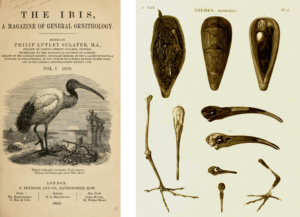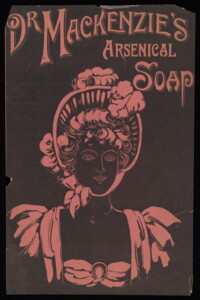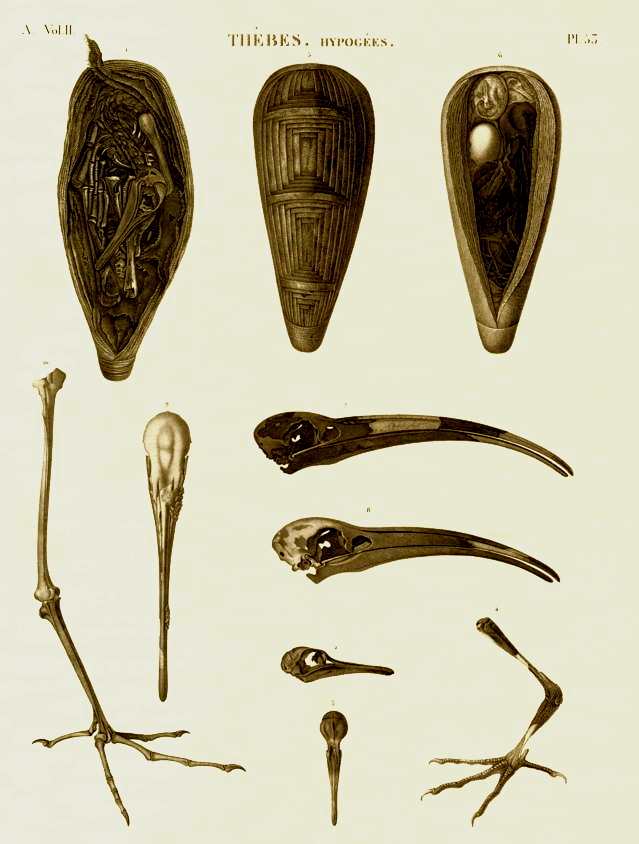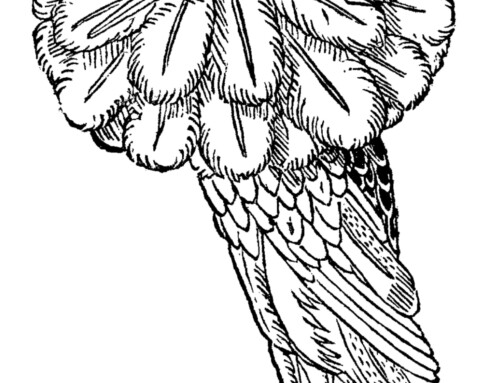
The oldest bird specimens currently held in museum collections are several mummified Scarlet Ibises from about 500 BC. Yes, that ibis, the bird chosen by the founders of the BOU to adorn the cover of their eponymous new journal in 1859.
Geoffrey St Hilaire and Jules-César Savigny ‘discovered’ literally millions of those mummified ibises in the catacombs of ancient cities during Napoleon’s 1798-1801 campaign to Egypt. Intrigued by the contents of those mummies, they brought a few back to Paris to study, and they were soon used by George Cuvier [1769-1832] to argue that species did not change over time (Curtis et al. 2018). Now there are ibis mummies in several museums worldwide, taken on many subsequent explorations of those catacombs.
Despite the tens—or even hundreds—of thousands of birds collected and preserved by naturalists between 500 BC and 1800, precious few of those skins can be found in museum collections today. Probably the oldest ‘modern’ bird skin is a cage bird, a Slate-coloured Solitaire, preserved on 15 September 1703 and now housed at the American Museum of Natural History (AMNH) in New York. That species was for centuries—and still is—a popular cage bird (Roldàn-Clará et al. 2017), chosen for its exquisite song, once described by the curator of the AMNH, Frank M. Chapman [1864-1945], as “the most beautiful bird song of all”. There are relatively few other bird specimens from the 1700s still available in museum collections today.
What happened to all those missing specimens? The answer, sadly, is that they were destroyed by fires, wars, earthquakes, shipwrecks, and, especially, insects. The great entomologist René Antoine Ferchaut de Réaumur [1688-1757] lamented the scourge of insect pests on bird specimens in the 1740s when he “had the Mortification to see them every day destroyed by ravenous insects, in spite of all the care that had been taken to preserve them” (Réaumur 1748). That insect problem, though, was soon solved once and for all by his countryman Jean-Baptiste Bécoeur [1718-1777].

Figure 1. Recipe for Arsenical Soap (Daudin 1800).
Bécoeur was a pharmacist and ornithologist who developed a soap containing arsenic that was effective in protecting skins from insects. He kept his discovery secret, though, in the hope that he could monetize it:
“I confess that if my discovery was relevant to the health or happiness of men…I would make it my duty to sacrifice the fruit of my labors to the public; but…I believe that I can wait without qualms for it to compensate me for the trouble and expense it has caused me, especially in view of the usefulness it may be in the future, because it is applicable not only to dried animals, but also to furs, draperies, body parts for anatomical study, in a word to anything susceptible to being eaten away by insects” (Bécoeur 1775; my translation from the original French).
In 1755, Bécoeur gave several of his arsenic-preserved bird specimens to the museum in the Jardin du Roi in Paris (Farber 1977), hoping to impress Buffon (i.e., George-Louis Leclerc [1707-1788]), arguably the leading biologist of the day. However, it was not until sixteen years after Bécoeur’s death, that his formula began to be used by taxidermists at Buffon’s museum—renamed the Muséum National d’Histoire Naturelle in 1793— possibly via Bécoeur’s nephew who worked there.
One of the first ‘modern’ textbooks of ornithology, Traité élémentaire et complet d’ornithologie, eventually published Bécoeur’s formula (Daudin 1800, pp. 445-446), provided by one of the museum’s taxidermists, Louis Dufresne [1752-1832]. Dufresne went on to publicize this method in his own publications on taxidermy (e.g., Dufresne 1820) and is generally credited with making the use of arsenic soap widely popular (Farber 1977).

Figure 2. MacKenzies Arsenical Soap (1896).
For the next 140 years, bird skins were largely preserved with arsenical soap. As a direct result both private and museum collections burgeoned to something over three million specimens by the middle of the 20th century. It was eventually realized that arsenic might be too dangerous for both taxidermists and anyone studying bird skins, so a variety of equally good chemical protectants began to be employed.
Specimens now held in the world’s museums are an invaluable window on the past, yielding insights into evolutionary processes and patterns, conservation, and taxonomy (Norris et al. 2024) thanks to the specimens preserved by Bécoeur’s formula for arsenical soap. But we also need to continue to add specimens to those museum collections to help inform future generations about the inevitable environmental changes to come.
Further Reading
Bécoeur, J-B. 1775. Fin de la Replique de M. Bécoeur á la lettre de M. Mauduyt, inserée dans le Journal de physique du mois de Novembre 1774. Journal encyclopédique (Juillet): 142–147.
Curtis, C., Millar, C.D., Lambert, D.M. 2018 The Sacred Ibis debate: The first test of evolution. PLoS Biology 16: e2005558. DOI 10.1371/journal.pbio.2005558
Daudin, F.M. 1800. Chapter 12: Sur l’art de la TAXIDERMIE considéré par rapport aux Oiseaux; c’est-à-dire sur l’art de dépouiller, de droguer, de conserver et de monter les Peaux d’Oiseaux. Pp. 439–462 in Traité élémentaire et complet d’ornithologie, ou, Histoire naturelle des oiseaux, first edition. Chez l’auteur, Paris. 474 pp.
Dufresne, L. 1820. Taxidermie, ou, l’art de préparer et de conserver la dépouille de tous les animaux, pour les musées, les cabinets d’histoire naturelle. Ouvrage utile aux personnes qui s’occupent d’histoire naturelle. Déterville, Paris. 102 pp.
Norris, K., Bond, A.L., Cooper, J.H., Adams, M.P., van Grouw, H., White, J., Stervander, M., Russell, D.G.D., Loader, S.P. 2024. Unlocking avian museum collections to enable and advance environmental change research. Ibis 166: 315-322. https://doi.org/10.1111/ibi.13271
de Réaumur, R. A. F. 1748. Divers means for preserving from corruption dead birds, intended to be sent to remote countries, so that they may arrive there in a good condition. Philosophical Transactions of the Royal Society of London 45: 304–320.
Roldán-Clarà, B., Toledo, V.M. & Espejel, I. 2017.The use of birds as pets in Mexico. Journal of Ethnobiology and Ethnomedicine 13: 35. DOI 10.1186/s13002-017-0161-z
Image credits
Top right: First IBIS cover (left) and Ibis mummies from Thebes: Commission Des Sciences Et Arts D’Egypte Creator, and Emperor Of The French Napoleon I.
Blog posts express the views of the individual author(s) and not those of the BOU.
If you want to write about your research in #theBOUblog, then please see here




